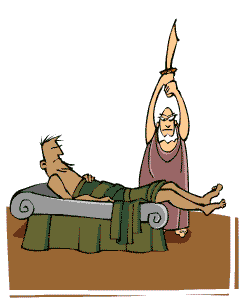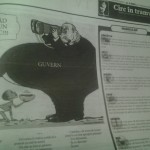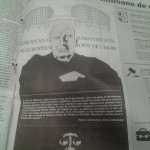 In this post I briefly present the first topic of my research in Moldova: newspaper strips, more precisely how elements of the comics’ medium (panels, speech bubbles, inscriptions) are used by editors to boost the quality of articles or even the quality of newspapers.
In this post I briefly present the first topic of my research in Moldova: newspaper strips, more precisely how elements of the comics’ medium (panels, speech bubbles, inscriptions) are used by editors to boost the quality of articles or even the quality of newspapers.
Reading the basic work on comics The Penguin Book of Comics: A slight history by George Perry, one discovers that a detailed chapter is designated to newspaper strips. Accordingly, many comics began as series of few panels, shared within pages of newspapers until publishers, recognizing their popular success, reedited them as separate periodicals (chapters of a story), and seeing the growing demand for these, ultimately republished them in book format.
In Moldova, local comics don’t exist (yet), however, all important  newspapers embody panels either to illustrate the content of articles or for entertainment, without connection to the texts. Panels appear in many numbers of Ziarul de Gardă, Adevărul, and Apusenii Liberi – just to mention the important ones. In the first picture we have a caricature of the government, a fat businessman, who cannot see the suffering, poor citizens from his belly. It’s placed next to the zodiac, in isolation. In the second picture, next to an article on the costs of the legal system, the panel shows the dominant figure of a judge sitting above a paragraph from the constitution to emphasize the burden placed on the country and government by the legal system.
newspapers embody panels either to illustrate the content of articles or for entertainment, without connection to the texts. Panels appear in many numbers of Ziarul de Gardă, Adevărul, and Apusenii Liberi – just to mention the important ones. In the first picture we have a caricature of the government, a fat businessman, who cannot see the suffering, poor citizens from his belly. It’s placed next to the zodiac, in isolation. In the second picture, next to an article on the costs of the legal system, the panel shows the dominant figure of a judge sitting above a paragraph from the constitution to emphasize the burden placed on the country and government by the legal system.
 In Understanding Comics and Making Comics Scott McCloud mentions two important traits/conditions of narration with succession of panels: a) The differences between the two images must reflect key moments of an action, so that readers may link the meaning between panels, in the gutter, where the action/process itself is imagined. b) There must be a change of focalization between panels to express movement or change of perspective, similarly to camera movement or zooming in film. Both a) and b) can be found in Moldavian newspapers. In the left picture the caricature continues the moment captured on the photograph expressing how the person reveals his true character, the process being condensed in the gutter between photo and caricature. In the right picture the frame moves from the overall view zooming in on the miniatures of former parties hanging on current political agendas.
In Understanding Comics and Making Comics Scott McCloud mentions two important traits/conditions of narration with succession of panels: a) The differences between the two images must reflect key moments of an action, so that readers may link the meaning between panels, in the gutter, where the action/process itself is imagined. b) There must be a change of focalization between panels to express movement or change of perspective, similarly to camera movement or zooming in film. Both a) and b) can be found in Moldavian newspapers. In the left picture the caricature continues the moment captured on the photograph expressing how the person reveals his true character, the process being condensed in the gutter between photo and caricature. In the right picture the frame moves from the overall view zooming in on the miniatures of former parties hanging on current political agendas.
I cannot stress enough the importance of caricatures, which constitute the majority of panels, usually containing speech bubbles, inscriptions and sequential relations between panels. Panels mainly accompany articles of political or economical interest. Apparently, satire dominates Moldavian political/economic attitudes, as reflected by the abundance of caricatures. Political/economic voices dominate media and popular culture. If any comics will be published hereafter, they’d be political satires fraught with caricatures.
Sources:
Pictures taken by Zsolt Nemes

